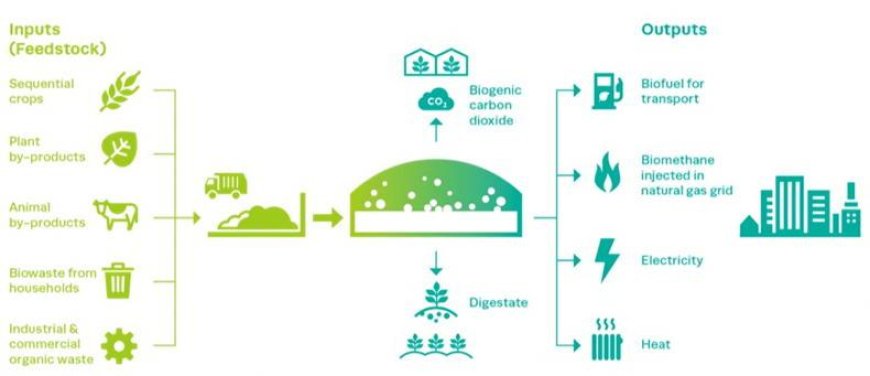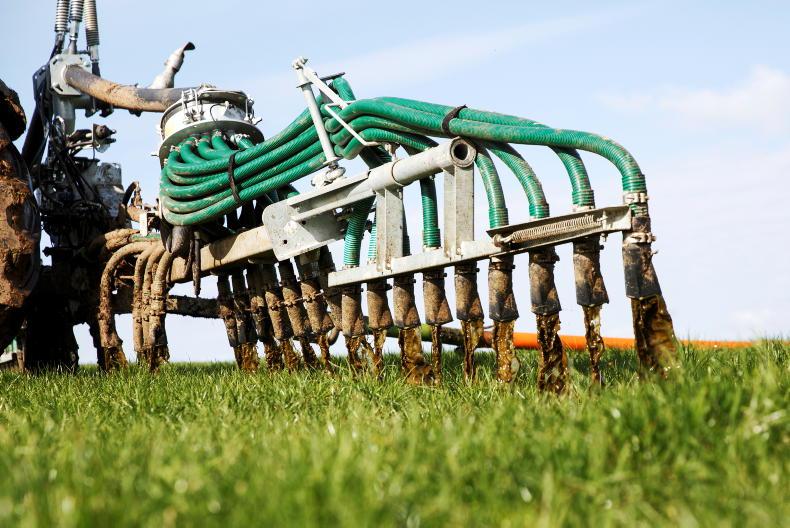Renewables Roadshow: learn about anaerobic digestion
Renewables Roadshow: learn about anaerobic digestion - Free Irish Farmers Journal

Despite all the hype surrounding Ireland’s emerging anaerobic digestion (AD) industry, there still remains a significant knowledge gap about how it will actually function.
Arguably, we won’t know the finer details until the first handful of projects are operational and integrated into the community. However, we have a good understanding of how similar plants operate in other countries, as well as insights from the Government as to how it envisages the sector will operate.
The Irish Farmers Journal’s Renewable Roadshow series aims to shed some light on this matter.
The event, which kicked off earlier this week in Cork, will feature a dedicated session on AD and its implications for farming.

What is anaerobic digestion?
The final session of each evening at the roadshows will focus on AD. For those unfamiliar, AD is the natural breakdown of organic material (such as slurry, crops, and food waste) by microorganisms in the absence of oxygen.
During this breakdown, biogas is released, which is made up of around 55% methane, 40% carbon dioxide and 5% other gases. This process can be controlled and managed in purpose-built, sealed metal or concrete tanks, known as AD plants, where the biogas is collected and used.
Biomethane is produced through the removal of carbon dioxide and other gases, concentrating methane to around 97% or higher. Chemically identical to natural gas, biomethane serves as a renewable alternative and can be used in existing gas appliances. The CO2 can also be captured, liquefied, and sold to industry.
What goes into an AD plant must come out in the form of digestate, which is the organic material remaining after the digestion process. Digestate is higher in available nutrients when compared to slurry.

Why now?
The Irish Government has set a target of 5.7 terawatt-hours (TWh) of biomethane production by 2030 under the Climate Action Plan, aiming to supply 10% of Ireland’s gas needs.
Achieving this target would require the development of 140 to 200 large-scale AD plants. Currently, we only stand at 0.001% of biomethane in our gas mix, so the challenge ahead is great.
These targets are driven by broader sectoral and national emission reduction targets and, if met, the AD sector could potentially save an estimated 2m tonnes of CO2 emissions per year.
Feedstock
It’s the Government’s stated aim to make biomethane production a suitable diversification option for farmers. It wants farmers to be able to own, operate, or supply feedstock to AD plants. However, for many farmers, the latter option will be the most immediate. Agricultural feedstock will be essential for supplying the network of AD plants.
The Renewables Roadshow will delve into what types of feedstocks are required and the potential benefits to farmers in supplying plants. For example, an AD plant could create a new export market for slurry, helping farmers in meeting their nitrate obligations.
Digestate
Digestate will play an important role in helping farmers reduce chemical fertilisers, while also assisting in a more balanced spread of nutrients across Ireland. AD can facilitate the movement of nutrients from where they are not needed to where they are needed.

The model
While the draft National Biomethane Strategy failed to excite, the final version of the Government’s roadmap to AD development is expected to contain answers to some significant questions. We’ll delve into the types of support needed to kickstart this industry and what has been committed so far.
Case studies
Finally, we’ll be joined by Barry Caslin, energy and rural development specialist with Teagasc, and Sean Finan, CEO of the Irish Bioenergy Association, to run through two case studies on AD:
- Case study one – building an anaerobic digestion plant.
- Case study two – how farmers can get involved.
The first case study will examine the economics of constructing and operating an AD plant in Ireland. It will compare a modern commercial biomethane project with a small-scale farm-based project.
The second case study will explore how farmers can get involved with AD other than through project development. This will include an indication of the economics involved in supplying an AD plant with grass silage, crops, manure, or slurries, as well as using digestate to reduce chemical fertiliser requirements.

Still time to register
The Irish Farmers Journal Renewables Roadshow will continue its tour next week and the remaining events will take place on:
- 16 April at the Newpark Hotel Kilkenny.
- 23 April at the Errigal Country House Hotel, Cavan.
- 30 April at the Athlone Springs Hotel, Athlone.
The roadshows are evening events, with doors open from 6.30pm. The session kicks off at 7:30pm sharp and will run until 10pm. Tea, coffee and sandwiches will be available. To register, simply open your camera and scan the QR code to access the registration link, or go to www.ifj.ie/renewables.
If you have any questions about renewable energy options for your farm, business or household, feel free to send us your enquiries ahead of the events at renewables@farmersjournal.ie.
The roadshow is being delivered in partnership with FBD, the Irish Farmers Association and Bord Gáis Energy.
SDGs, Targets, and Indicators Analysis
1. Which SDGs are addressed or connected to the issues highlighted in the article?
- SDG 7: Affordable and Clean Energy
- SDG 9: Industry, Innovation, and Infrastructure
- SDG 12: Responsible Consumption and Production
- SDG 13: Climate Action
- SDG 15: Life on Land
The article discusses the anaerobic digestion (AD) industry in Ireland, which is connected to several SDGs. SDG 7 focuses on affordable and clean energy, which is relevant as AD produces biomethane as a renewable alternative to natural gas. SDG 9 relates to industry, innovation, and infrastructure, as the development of AD plants requires infrastructure and technological innovation. SDG 12 addresses responsible consumption and production, as AD helps reduce CO2 emissions and promotes sustainable waste management. SDG 13 focuses on climate action, as AD can contribute to reducing greenhouse gas emissions. Finally, SDG 15 relates to life on land, as AD can facilitate the movement of nutrients from where they are not needed to where they are needed.
2. What specific targets under those SDGs can be identified based on the article’s content?
- SDG 7.2: Increase the share of renewable energy in the global energy mix
- SDG 9.4: Upgrade infrastructure and retrofit industries to make them sustainable
- SDG 12.5: Substantially reduce waste generation through prevention, reduction, recycling, and reuse
- SDG 13.2: Integrate climate change measures into national policies, strategies, and planning
- SDG 15.3: Combat desertification, restore degraded land, and soil
Based on the article’s content, the specific targets identified include increasing the share of renewable energy in the global energy mix (SDG 7.2), upgrading infrastructure and retrofitting industries to make them sustainable (SDG 9.4), substantially reducing waste generation through prevention, reduction, recycling, and reuse (SDG 12.5), integrating climate change measures into national policies, strategies, and planning (SDG 13.2), and combating desertification, restoring degraded land, and soil (SDG 15.3).
3. Are there any indicators mentioned or implied in the article that can be used to measure progress towards the identified targets?
- Percentage of biomethane in the gas mix
- Number of large-scale AD plants developed
- Reduction in CO2 emissions per year
- Amount of digestate produced
- Amount of nutrients moved through AD
The article mentions or implies several indicators that can be used to measure progress towards the identified targets. These include the percentage of biomethane in the gas mix, which indicates progress towards increasing the share of renewable energy (SDG 7.2). The number of large-scale AD plants developed can be used to measure progress towards upgrading infrastructure and retrofitting industries (SDG 9.4). The reduction in CO2 emissions per year can be used to assess progress in waste reduction and climate action (SDG 12.5 and SDG 13.2). The amount of digestate produced and the movement of nutrients through AD can be indicators of progress in responsible consumption and production and combating desertification (SDG 12.5 and SDG 15.3).
4. Table: SDGs, Targets, and Indicators
| SDGs | Targets | Indicators |
|---|---|---|
| SDG 7: Affordable and Clean Energy | 7.2: Increase the share of renewable energy in the global energy mix | Percentage of biomethane in the gas mix |
| SDG 9: Industry, Innovation, and Infrastructure | 9.4: Upgrade infrastructure and retrofit industries to make them sustainable | Number of large-scale AD plants developed |
| SDG 12: Responsible Consumption and Production | 12.5: Substantially reduce waste generation through prevention, reduction, recycling, and reuse | Reduction in CO2 emissions per year |
| SDG 13: Climate Action | 13.2: Integrate climate change measures into national policies, strategies, and planning | Reduction in CO2 emissions per year |
| SDG 15: Life on Land | 15.3: Combat desertification, restore degraded land, and soil | Amount of digestate produced, Amount of nutrients moved through AD |
Behold! This splendid article springs forth from the wellspring of knowledge, shaped by a wondrous proprietary AI technology that delved into a vast ocean of data, illuminating the path towards the Sustainable Development Goals. Remember that all rights are reserved by SDG Investors LLC, empowering us to champion progress together.
Source: farmersjournal.ie

Join us, as fellow seekers of change, on a transformative journey at https://sdgtalks.ai/welcome, where you can become a member and actively contribute to shaping a brighter future.







